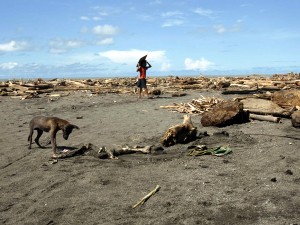Things to do when living in hazardous area and rain is heavy

A stray dog approaches a carcass of water buffalo Tuesday amidst debris of mostly logs which were washed ashore by the onslaught of Tropical storm Sendong last Friday in Iligan City. AP/Bullit Marquez
Amid weeks of nearly nonstop rain, rivers have topped their banks and mountainsides have collapsed, inundating low-lying communities, pasture lands, and croplands with water, mud and even uprooted trees.
While such disaster may seem unpreventable, communities and families could still do some sort of preparation especially those located near river banks or in areas prone to landslide.
Taken from various public safety organizations and emergency management agencies, the following tips should be considered to help communities and families be better prepared in dealing with the perils of flooding and landslide.
Getting prepared and being ready to assist our neighbors will help reduce the devastating effects of any disasters.
Sandbag dikes. While communities and families may not be able to stop an advancing floodwater, the construction of a sandbag dike along river banks or around a house may be able to delay its destructive power and give the household members more time to escape.
However, building a dike requires special procedures to achieve maximum strength and effectiveness against rampaging water or mud. Should you choose to construct a sandbag dike to protect your property in the event of a flood, constructing a trench first will serve as an affective foundation (a foundation of at least one sack in depth and two sacks wide may already be enough).
To effectively provide protection from the forces of flooding water or mud, a dike must be three times as wide at its base as it is high, thus, if you intend a one-meter-high structure, it should have a three-meter-wide base.
Remember, sandbags should never be filled more than half-full and must be laid in alternating crisscross directions. The base level should be laid parallel to the flow of the water while the second level should be laid perpendicular to the flow, with the third level again laid parallel.
Beware of moving water. Remind family members to avoid walking through moving water. Remember that six inches of moving water can knock a fully grown person off his or her feet. If one must walk in a flooded area, walk where the water is not moving or use a stick to check the firmness of the ground in front of you.
Also, do not drive into flooded areas. If floodwaters rise around your car, abandon the car and move to higher ground since you and your vehicle can be quickly swept away as floodwaters rise.
Leave your house. If you suspect that a landslide is occurring or about to occur in your area, you should leave immediately. Getting out of the path of a landslide or debris flow is your best protection.
Inform neighbors as they may not be aware of the potential hazard. Advising them of a threat may help save lives. Help neighbors who may need assistance to evacuate (and take your pets with you when you leave, provided you can do so without endangering yourself).
Prepare emergency bag. Prepare a family emergency kit ahead of time and have a grab and give a bag for each family member if you will be needed to be evacuated on short notice.
If rising floodwaters or falling rocks threaten the safety of you and your family and you must evacuate your home, ensure that supply of all essential medications, especially for those on prescription drugs, for each member of the family (it would be wise to maintain a minimum two-week supply of prescription drugs).
Carry all items necessary for the care and feeding of any infants in the family, including diapers, feeding bottles and foods.
In the emergency bag, also keep a water, a fairly long and sturdy rope, battery-powered radio with extra batteries and a flashlight with extra batteries.
Ensure each family member has identification, especially the young children (name tags on clothing, wallet cards and wristbands are all useful and seal all personal documents and family papers in plastic). Also, prearrange a meeting place in case you and other members of your household get separated.
Save appliances, furniture. If your house or property is threatened by immediate flooding or landslide, it is important not only to be prepared for the eventual calamity, but to make as many preparations as possible for the return to normal living once the flood has subsided.
If there is time, one should consider moving some appliances above the anticipated flood level. Radios, televisions, stereo systems and other home electronic systems should be moved above the flood level as repairs to such items following submersion is not practical.
Cleaning up after a flood. While flood safety is paramount during a flood, you should also be cautious after the flood. Avoid downed power lines and beware of animals like snakes that could have made their homes in standing water.
Personal responsibility. Although there are many private, nongovernment organizations as well as municipal and provincial agencies ready to provide aid should a devastating flood or landslide occur, we should remember that it is still the personal responsibility of each of us to be prepared to deal with disaster should it unexpectedly strike.
Remember that agencies from all levels of government can do their jobs more efficiently, if each one of us takes personal responsibility for preparedness.